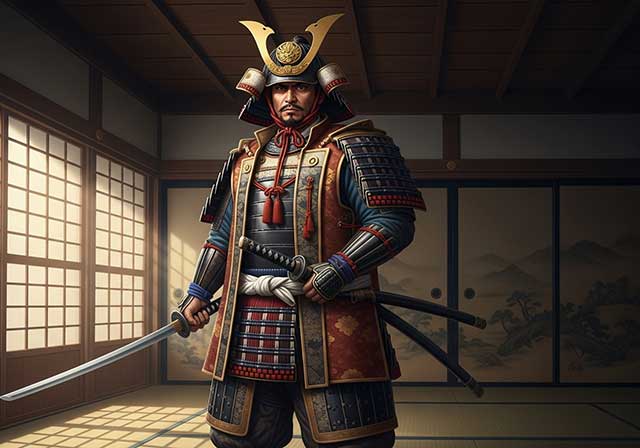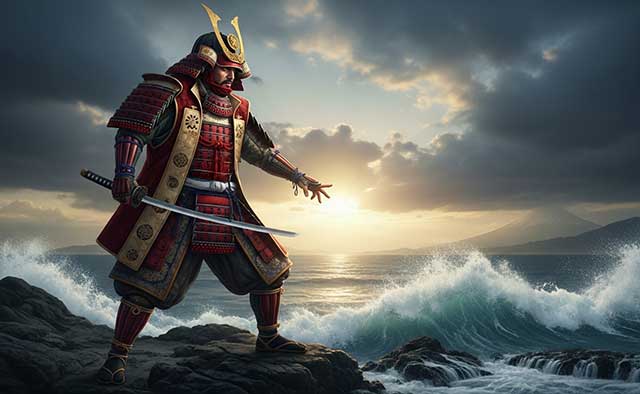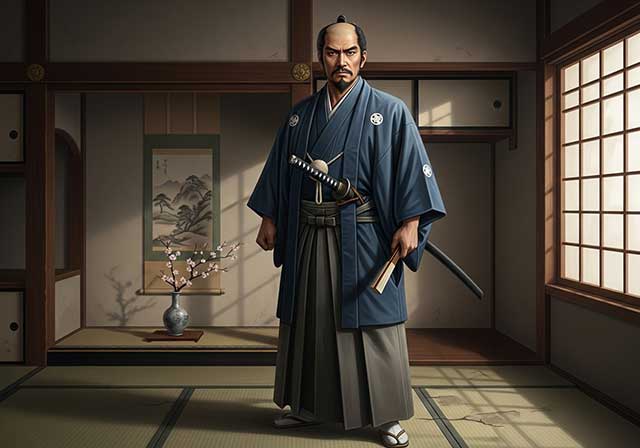
The Amago clan (also spelled Amako) was founded in 1392, when Sasaki Takahisa, who was orphaned at the age of three, took the new surname Amago, meaning “son of a nun,” in honor of the nun who raised him. Since the Sasaki family descended from Emperor Uda (866–931), the Amago clan traced its lineage back to this emperor. From around 1396, the Amago clan's headquarters was the mountain castle of Gassan-Toda in Izumo Province. Until the start of the Onin War, the Amago clan remained a minor clan in the service of the Kyogoku clan, which was also a descendant of the Sasaki clan. The Amago clan historically held the position of vice-governor of Izumo Province.
Amago Tsunekata was the eldest son of Amago Kiyosada and was named Matashiro in his childhood. At the age of fifteen, he was already working as his father's deputy and overseeing the taxation of goods passing through the province. In 1477, Tsunekata succeeded his father as vice-governor and was granted the right to use a character from the name of Governor Kyogoku Masatsune. Taking advantage of the power vacuum that had formed after the Onin War, Tsunehisa began to actively expand his possessions, confiscating the lands of temples, shrines, and small landowners. This led to a conflict with the governor, who in 1484 dismissed Tsunehisa and his father from all their posts and took away their castle, Gassan-Toda. Having lost his support, Tsunekisa was forced to wander until he received support from Yamanaka Katsusige and other allies of the Amago clan. After that, Gassan-Toda Castle passed into the possession of the Enya clan.
Two years later, Tsunekisa was able to regain the castle. According to one version of events, during the New Year celebrations of 1487, his men dressed up as festival dancers, infiltrated the fortress, and suddenly attacked the Enya clan warriors, who were not expecting an attack. During the battle, the new owner of the castle was killed. After capturing Gassan-Toda, Tsunekhisa began to systematically subjugate the local feudal lords and by 1508 had established complete control over the province of Izumo, finally overthrowing the power of the Kyogoku clan.
The expansion of the Amago clan's influence soon led Tsunekisa into conflict with his powerful neighbor, the Ouchi clan. Taking advantage of the absence of the head of the Ouchi clan, Yoshioki, who twice—in 1508 and 1511—marched on Kyoto, Tsunekisa began to spread ideas of rebellion against the Ouchi clan's rule among the minor feudal lords of the Chugoku region. In October 1518 (some sources date this event to 1513), Tsunekisa invaded Hoki Province. At that time, one of his vassals, Sakurai Soteki, rebelled and was besieged in his castle by the troops of Amago Masahisa, Tsunekisa's eldest son and heir. During the siege, Masahisa was killed by an enemy archer.
The death of his son deeply shook Tsunekisa, and he intended to retire, handing over leadership of the clan to his brother Amago Hisayuki. However, Hisayuki refused to take over, and Tsunekisa reconsidered his decision. He later appointed his grandson, Amago Akihisa, as his heir.
In 1522, Tsunekisa invaded Aki Province and accepted the oath of allegiance from Mori Motonari, the future influential feudal lord of the Chugoku region. The following year, in 1523, he again opposed the Ouchi clan, instructing Motonari to besiege Kagamiyama Castle, which was defended by Kurata Fusanobu. The castle resisted stubbornly and was taken only thanks to the strategic talents of Mori Motonari, who, resorting to cunning, persuaded the uncle of the castle commander, Kurata Naonobu, to betray him. At the same time, Tsunekhisa attempted to take Kanyama Castle, but failed.
Despite Motonari's success, Tsunekisa ordered Naonobu's execution, fearing the growing influence of his vassal, even though Motonari asked for his life to be spared. This decision caused mistrust between the two leaders, and two years later, Mori Motonari left the Amago clan and became a vassal of the Ouchi clan.
In 1528, after the death of Ouchi Yoshioki, Tsunekisa intensified his actions against the Ouchi clan and directed his forces to capture the province of Iwami, known for its rich Iwami Ginzan silver mines, which often made the territory a battleground for local feudal lords. However, Tsunekisa's ambitious plans were temporarily interrupted by a two-year rebellion led by his third son, Enya Okikisa (1497–1534), who was dissatisfied with the distribution of the inheritance. In 1532, the rebellion was suppressed by the troops of Tsunekisa's brother, Amago Haruyuki, and Okikisa himself committed suicide. Despite the victory, the internal conflict weakened the Amago clan.
After these events, Tsunehisa abdicated in favor of his grandson Amago Akihisa (Haruhisa), but continued to participate in the most important affairs of the clan.
Amago Tsunekisa was an outstanding strategist and skilled administrator. Among his achievements, the construction of the magnificent Shinto shrine Kitsugi in Izumo Province in 1530 stands out. At the height of his power, Tsunekisa ruled over most of the Chugoku region, including the provinces of Inaba, Hoki, Izumo, Iwami, Oki, Harima, Mimasaka, Bizen, Bitchu, Bingo, and Aki. Tsunehisa died in 1541 and was buried alongside his father at Tokōji Temple.
See also
-
Ouchi Yoshioki

Ouchi Yoshioki, the ruler of the provinces of Suo, Nagato, and Iwami, was one of the most capable military commanders and politicians of the late 15th and early 16th centuries. The son of Ouchi Masahiro, he governed from his residence in Yamaguchi in the province of Suo. In 1499, Yoshioki gave refuge to Shogun Ashikaga Yoshitane, who had been driven out of Kyoto by Hosokawa Masamoto. Shogun Yoshizumi, Masamoto’s protégé, ordered the lords of Kyushu to unite their forces against Yoshioki; however, they did not dare to do so, fearing the power of a man who by that time controlled six provinces. Having gathered a substantial army, Yoshioki marched from his native Suo toward Kyoto in order to restore Shogun Yoshitane to power.
-
Otomo Sorin

Ōtomo Yoshishige came from a noble lineage, being the eldest son of Ōtomo Yoshiaki, the ruler of Funai Province. The roots of the Ōtomo family traced back to Fujiwara Hidesato, the adopted son of Nakahara Chikayoshi. Fujiwara served Minamoto Yoritomo during the Genpei War and took part in battles in Mutsu Province in 1189. In 1193, he was appointed shugo of Buzen and Bungo Provinces, after which he adopted a new surname—Ōtomo.
-
Okudaira Sadamasa

Sadamasa was the son of Okudaira Sadayoshi and took part in several battles under Tokugawa Ieyasu, distinguishing himself in the Battle of Anegawa in 1570, where he took two heads. Around 1572 he was forced to enter the service of the Takeda clan, but after the death of Takeda Shingen in 1573 he returned to Tokugawa, leaving Tsukude Castle together with his men. As a result of this defection, Takeda Katsuyori ordered the execution of Sadamasa’s wife and brother, who were being held as hostages.
-
Okubo Tadatika

Tadatika, the son of Okubo Tadayō, entered the service of Tokugawa Ieyasu at the age of eleven, and took his first head in battle when he was sixteen. After the establishment of the Tokugawa shogunate, he was appointed as a rōjū — a senior bakufu official — and was regarded as one of Ieyasu’s most trusted advisors, alongside Honda Masanobu. He is also known for his military chronicle Mikawa Monogatari, which describes Ieyasu’s rise to power and the early years of the Tokugawa shogunate.
-
Okubo Nagayasu

Nagayasu was the second son of Okura Nobuyasu, a sarugaku theater actor from the Takeda clan. Takeda Shingen recognized the young man’s potential and took him into service, appointing him as a vassal to his general, Tsuchiya Masatsugu. During this period, Nagayasu changed his family name to Tsuchiya. He was entrusted with developing the Takeda clan’s gold mines as well as handling matters related to taxation.
-
Nitta Yoshisada

Nitta Yoshisada was a loyal soldier of Emperor Go-Daigo, who in the 1330s attempted to restore direct imperial rule in Japan. The Nitta family was related to the Ashikaga house and was older in lineage. However, they did not join Minamoto Yoritomo at the start of his war with the Taira, as the Ashikaga did, and therefore did not receive high positions in the Kamakura shogunate. This may have been one of the reasons why Yoshisada rose against the Hōjō clan in 1333.
-
Natsume Yoshinobu

Yoshinobu, a long-time vassal of the Matsudaira and Tokugawa clans, governed Hamamatsu Castle on behalf of the Tokugawa house. During the clashes between the Imagawa, Takeda, and Matsudaira clans, he served in the garrison of Nagasawa Castle and in 1562 took part in raids under the command of Itakura Shigezane. When, in 1563, a revolt of the Sōtō-shū sect followers broke out in Mikawa Province, Yoshinobu joined the rebels together with Honda Masanobu and Hachiya Sadatsugu.
-
Nambu Nobunao

The Nambu clan was an ancient and powerful family that traced its lineage back to the Minamoto shoguns and had controlled a significant part of the Tohoku region in northern Honshu since the 12th century. Nobunao was born in Ikatai Castle, located in what is now the city of Iwate. He was the second son of Ishikawa (Nambu) Takanobu, the 22nd head of the Nambu clan. In 1565, Nobunao’s uncle, Nambu Harumasa, adopted him, brought him to Sannohe Castle, and named him his heir, later giving his daughter in marriage to him.

